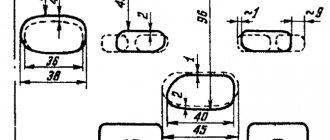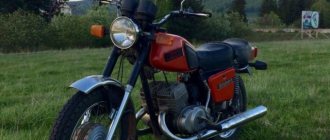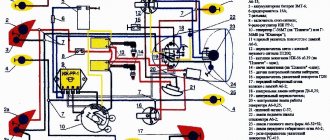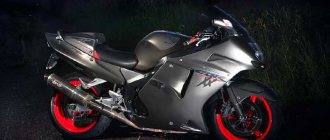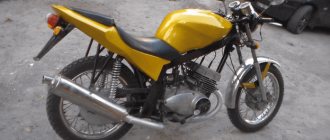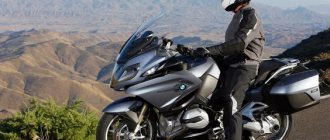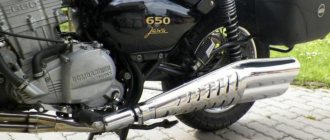The IZH Jupiter 5 motorcycle is a well-known monster of the Soviet motorcycle industry, produced from 1987 to 2008 . Massive and archaic, it represents a superficial reworking of previous generations of the series, in which the designers attempted to correct their shortcomings with relative success. Due to its good suitability for rural areas , the bike quickly became popular; moreover, due to a different engine, it was superior in power to its main competitor, the fifth “Planet”. Its engine was considered successful, and it was borrowed for another model of Izhevsk Motorcycle, the first Russian cruiser, which at one time was used even by traffic police officers.
Design
It would be naive to expect design delights from Soviet motorcycles. The bike looks similar to all other models produced by motorcycle factories of those years, but this is not surprising - the fifth generation was developed on the basis of the fourth, and the fourth - on the basis of the third, created back in the 70s of the last century. But many bikers, nostalgic for the old days, appreciate this rugged simplicity. Moto Izh Jupiter 5 does not stand out in any way externally from other bikes from the times of the USSR, which you can easily see for yourself by looking at the photo.
Technical characteristics of Izh Jupiter 5
In general, the characteristics of the Izh Jupiter 5 motorcycle corresponded to its time. But in the 2000s, when it continued to be produced, it could no longer compete with imported models. The Chinese had already flooded the market with budget, but still more modern models, and a flood of used motorcycles poured from Japan, Europe and the USA. The characteristics of the Izh Yu5 engine were not bad, but everything else was hopelessly outdated a couple of decades ago.
Engine
The technical characteristics of the engine are not amazing - two cylinders, 347 cubic meters . There is enough horsepower, as much as 24 , torque - 34 Nm . Compared to the previous generation, the engine lost 4 hp, but gained torque, and there was also noticeably more thrust at the bottom, so in general the characteristics of the Izh Jupiter 5 became more balanced. But the engine remained two-stroke , and oil mixed with gasoline must be poured into the gas tank in a ratio of 1 to 25 . But it can easily digest even AI-76, not to mention AI-80. The declared maximum speed is 125 km/h , and it can be achieved on Jupiter without a stroller. And if you look at the engine in cross-section, it turns out that it subtly resembles all the engines at once that were ever produced at the Izhevsk Motor Plant.
Transmission
Standard 4-speed transmission , where first gear is downshifted and all others are upshifted. It has never been reliable, but thanks to its high maintainability and availability of spare parts, Soviet motorcyclists quickly learned how to solve problems on their own. Some garage craftsmen even completely rebuilt the transmission, adding a fifth gear to the bike, but these were custom ones.
Chassis and brakes
The chassis was developed back in the 70s, if not earlier, and in Jupiter 5 it has remained virtually unchanged. A conventional steel frame with a telescopic fork in front and ancient shock absorbers a la “candle” in the rear, plus drum brakes on both wheels. The effectiveness of the suspension and braking system was mediocre even for its time, but they also had a significant advantage - endurance and maintainability. On modern motorcycles (except perhaps enduro), oil from the fork quickly begins to leak on rural dirt roads, and Izh Yu5, it seems, can ride without it at all. But we still do not recommend .
Electronics
The fifth generation Jupiter does not have the same electrical problems that the fourth had. In fact, this model is the same Jupiter 4, but with a number of corrected shortcomings, such as regular wiring problems. Gasoline consumption has also become lower thanks to a redesigned ignition. In general, the electrical circuit has changed slightly, but the weak points that regularly served as a source of headaches for owners have been removed.
Weight and dimensions
The dimensions of the bike can be called average, as well as its weight. How much does Izh Jupiter 5 weigh? By modern standards - quite a lot, about 160 kg , and this is only dry weight . But the motorcycle engine is located low, so the center of gravity is also shifted down. The relatively large weight is due to the fact that in the USSR they did not skimp on hardware, and plastic elements were practically not used. If something can be made from iron, it must be made from iron! That is why the weight of the Izh Jupiter 5 engine is about a quarter of its total mass, if we consider the specimen without a sidecar.
Controllability
This mastodon handles mediocrely , and not least because of the ancient design, and with a stroller the handling becomes even worse. But the cradles for Izh Jupiter 5 were also produced separately, so if you don’t need it, you can always disconnect it. But don't forget about weak brakes , which are not enough to effectively stop a massive bike. On the other hand, the Izh stroller is good because you can load a lot of spare parts and other goods into it when going on a long trip, since its volume allows this.
Fuel consumption
Compared to the previous generation, gasoline consumption has noticeably decreased, from 7-8 liters to 5.5-6 . The declared figures are about 5.9 liters at an average speed of 90 km/h . The quality of gasoline does not matter; the carburetor calmly consumes everything that burns. Tank volume - 18 liters .
Motorcycle IZH Jupiter 5 owner reviews
- Alexander, Tver region. I am the owner of a motorcycle IZH Jupiter 5, which is a worthy representative of the middle class. Quite a powerful device, with a 25-horsepower engine, which is unpretentious to use and consumes little gasoline - around 6-7 liters per 100 km. I owned this vehicle for several years and will never forget it. The engine is a two-stroke petrol engine, its dynamics are not bad for this class - at least the Jupiter accelerates quickly on a straight road. And it’s already reluctant to take turns. The motorcycle does not like high revs. From my own experience, I will say that this model is well suited for transporting heavy loads on a stroller, as well as on a trailer. The Jupiter is a suitable vehicle for rural areas, it has a durable chassis that can withstand all the potholes and potholes that can be found on country and rural paths. You can carry two passengers, and you can fit several bags of potatoes (for example) in the trunk. The motorcycle copes well with such a load. Unfortunately, breakdowns occur periodically, but at the same time, many spare parts are inexpensive but of poor quality. I was pleased with the high maintainability - almost every part in the motorcycle is in an accessible place, it is easy to remove and replace. Some parts can be found in online stores or at disassembly sites.
- Alexey, Ryazan. A reliable, unpretentious and inexpensive motorcycle to operate. I was impressed by the affordable price; I bought Jupiter in 2006. I quickly got comfortable behind the wheel and was pleased with the ergonomics of the location of the levers and other controls. The gearbox works smoothly. The 26 horsepower engine is capable of operating at both plus 30 and minus 30 degrees. What I'm saying is that the engine is adapted to various temperature changes and starts with half a turn. The maximum speed is around 100 km/h, but 100 km/h is enough for me, which Jupiter picks up easily and naturally. At second speed you can accelerate to 80 km/h. The main thing is to set up the carburetor correctly. I have a semi-automatic transmission, this is where the clutch acts as a supplement to the gas when starting to move. This solution is optimal for quickly gaining speed, without any jerks or delays. In addition, a semi-automatic does not increase gas mileage, unlike a full-automatic. So, in the city Jupiter consumes a maximum of 7-8 liters. This is certainly a lot, but I can imagine what would happen if Jupiter was equipped with a machine gun. Overall, this is a well-made motorcycle that is suitable for those people who are on a budget. I admit, this is not the best option in terms of reliability, but with direct hands, Jupiter will last as long as its owner wants. The grandchildren will also ride.
- Vladimir, Krasnodar region. I drive a 1994 Jupiter. I bought this two-wheeler in 2010 for 10 thousand rubles. The vehicle has been in use for eight years; the previous owner took care of it as if it were his own wife. Perhaps I was lucky - I didn’t even have to restore anything, the Jupiter was so good as new, the mileage at the time of purchase was 11 thousand kilometers. The engine quickly picks up speed and provides decent acceleration dynamics. I liked the comfortable and energy-intensive suspension, adapted to bad roads and obstacles. The motorcycle is cheap to maintain and does not require serious expenses. The main costs go to fuel. By the way, in the urban cycle you can keep within 5 liters per 100 km. There is support for cheap 76-octane gasoline. I've been riding Jupiter since I was 18 years old. I then received a category A license, and by that time I had found a suitable copy. For me there is no better motorcycle in terms of price-quality ratio. Many Jupiter owners complain about a problem associated with malfunctions in the right or left cylinder. Fortunately, this problem can be fixed in a matter of minutes - the Internet can help. Jupiter is very playful, rides smoothly and quickly, without extraneous noise or vibrations, unlike the Planet.
- Boris, Yaroslavl. Jupiter-5 is an easy-to-maintain, inexpensive and powerful motorcycle. This is to put it briefly. Perhaps this model is one of the best Soviet motorcycles equipped with a two-stroke engine. Even the good old Ural is inferior to Jupiter in reliability, speed and efficiency. This is not surprising, since it is based on a Soviet motorcycle from the 1940s! My Jupiter is equipped with a side stroller; you can also attach a trailer and carry gravel, sand, firewood and other household and construction materials. The cylinder block with the crankshaft was borrowed from the KRAZ timber truck. And in general, Jupiter is a worthy addition to full-fledged trucks; it is suitable for low-income families, as well as people working for themselves. I'm just one of those people. In the 90s, we earned as much as we could, like everyone else. Fortunately, we still had money in our savings book; we had to drain it quickly, because there was crazy inflation back then. Thus, money appeared for this motorcycle. Of course, breakdowns happen repeatedly. But spare parts are cheap, they are always in stock. Gasoline consumption is maximum 10 liters that I saw. This is quite a lot for a middle-class motorcycle and, perhaps, this is the only serious drawback of Jupiter. You can fill in both 92nd and 80th gasoline. True, at 80 the motorcycle accelerates faster. I worked on Jupiter with a side trailer, doing long motorcycle rides, 1-1.3 thousand kilometers long at a time. I drove along broken roads, over potholes and gullies. Fortunately, Jupiter 5 survived most of the tests. Of course, there were some breakdowns that could be fixed in the field. In the 90s, motorcycles of this brand were plagued by breakdowns of the piston crankshafts. Of course, everything is connected with the low quality of spare parts. At that time, they didn’t live, but survived, and they didn’t think much about quality. I have repeatedly changed spare parts in Jupiter and serviced it in a timely manner. The last time I did a major renovation was five years ago. The engine runs smoothly and balanced, and does not suffer from factory problems characteristic of Izh Planet engines and other single-cylinder engines (they are characterized by nervous trembling on the steering wheel and ringing of parts). The powertrain in the Jupiter has a pleasant, unobtrusive growl and a top speed of 120 km/h. True, at such a speed you need to constantly steer, because the motorcycle scours from side to side. I have the air cooled version. Liquid cooling is useless; it only causes more problems. The engine of my Jupiter does not overheat and starts up confidently in cold weather. Model 1992, an excellent Russian bike for the budget-conscious user. Consumes no more than 6-7 l/100 km in the city.
- Ruslan, Rostov region. I bought this device for 7 thousand rubles. Used for two years. So far there are no shortcomings. I immediately appreciated the key advantages of the Jupiter 5 motorcycle - its efficiency, fast semi-automatic gearbox, soft suspension and high maintainability. Sometimes the ignition goes wrong, it needs to be adjusted, then there will be no problems. I bought Jupiter disassembled. After a month of painstaking work associated with finding the necessary spare parts and then assembling the motorcycle, setting up the wiring, etc., I made the first start - the motorcycle started up. I was happy, but not for long - after two months the engine died. A major overhaul would no longer help him. It overheated greatly even in cold weather. At the service center they advised me to change the engine, take a motor from Jupiter-3 (I have Jupiter-5). In general, there was not much choice. After adjusting the carburetor, the maximum speed was 150 km/h - for comparison, the original engine from Jupiter-5 is designed for only 120 km/h. The engine is easy to maintain and does not cause unnecessary problems. The same applies to handling - the Jupiter steers willingly and confidently turns into sharp turns; there are no skids. The engine itself is heavier than that of the fifth model, but the dynamics are no worse, and even better - after all, the maximum speed has increased. Gasoline consumption is 5-6 liters per hundred. On light off-road it turns out to be 7 liters.
- Konstantin, Minsk. Jupiter-5 has two key advantages: acceleration and low maintenance costs. The design is so-so, not for everybody. Another drawback is mediocre reliability. The motorcycle constantly breaks down. But overall it's a good bike. It cost me 40 thousand rubles. The cost of a supported model now starts from 2 thousand rubles. I bought Jupiter-5 in 1996 for 12 thousand. It was a new motorcycle, with a two-stroke carburetor with 18 horsepower, which allowed it to accelerate to 130 km/h. The power reserve is decent, and gasoline consumption is around 4 liters per 100 km. The gas tank volume is 21 liters. The two-cylinder engine constantly growls, vibrates and makes noise, vibrations from it transfer to the frame, steering column and seat. But the dynamics are excellent, largely thanks to the fast 4-speed gearbox. Drum brakes are more reliable than disc brakes. Of course, this is not my only motorcycle that I still have in my garage. There are both Voskhod and Ural. I love motorcycles, sometimes I take part in motorcycle races on the highway and cross-country. Jupiter-5 brings sheer pleasure from such long trips. Of course, I always take the necessary spare parts with me.
- Maxim, Sverdlovsk. In 2021, I became the owner of an IZH Jupiter-5 motorcycle, which is fun to ride. But this is still Russian technology, which sometimes breaks down. In addition, it is supported, model year 1984. I bought it for 5,000 rubles from the second owner. Of course, before purchasing we checked everything, started the engine, listened to the speed, adjusted the carburetor, etc. In general, during inspection everything worked perfectly. However, after they settled with the owner and brought the Jupiter-5 to my garage, they discovered a malfunction - it turned out that the piston ring was broken, and the piston itself was broken. I had to order a new piston. I also installed new rings. However, the right cylinder continued to work only when the speed increased (that is, when you press the gas). At idle, one cylinder practically did not work. But the motorcycle was quite running, you can ride. One day we went out into the countryside to visit a friend, and suddenly the right cylinder began to “sneeze.” I decided to get there and then see what was going on. I turned the ignition, pulled everything and reconfigured it properly, but the cylinder still continued to sneeze. In short, I gave up on everything and went to bed - they say, he’s on the move anyway. The next day I rode again and the bike completely died. It refused to start until I found another motorcycle to “light it up” so to speak. I had two reasons - either the brushes were worn out, or the generator stopped working. Fortunately, local craftsmen in the village helped solve the problem. The motorcycle rides well, but sometimes it suffers from breakdowns, which it is not always possible to solve on your own. You need to hire “specialists” or take them with you all the time). Jupiter-5 is a very economical model that consumes an average of 4-5 liters per 100 km.
- Sergey, Stavropol region. I don’t know about others, but my Jupiter almost never breaks. I have a version with an unpretentious two-cylinder engine, a motorcycle produced in 1998. I bought it for 4 thousand rubles in 2021. In use for a year and a half, during this time I managed to study all the pros and cons of Jupiter, and I can conclude that the two-wheeler turned out to be worthy. The only thing that bothers me is the poor cross-country ability in muddy ground. Jupiter is completely unsuitable for off-road use. I bought the IZH in a damaged state - the previous owner had the motorcycle in the garage for six years and would not start. I also discovered that the garage was leaking in places due to holes in the roof. Fortunately, the two-wheeler was on the move - the engine started. I thought things were bad, but I only had to replace the battery and add new consumables - gasoline and oil. The motorcycle rode confidently and dynamically - the maximum speed was 120 km/h. Naturally, I didn’t drive it too hard right away, because first I had to break it in (after all, the bike was after six years of “hibernation”). In general, everything is fine with the chassis, I decided to tidy up the design of the motorcycle. I dismantled the fuel tank and began sanding, cleaning and painting. Fortunately, I managed to modernize Jupiter, which began to look like it came from the factory. I repeat once again - on the highway and on dry ground the Izh Jupiter 5 drives great, but in the mud or on any road it sits on its belly and skids helplessly, and even skids. In addition, off-road, the motorcycle consumes gasoline - it turns out to be around 10 liters, which is simply unacceptable for a middle-class motorcycle. Even the Planet is more economical, and at the same time irons out soggy soil much more confidently. The Jupiter's engine is quite revving, but the cylinders are constantly acting up - first one, then the second. You have to reconfigure from time to time. But it happens that even adjusting the cylinders does not help, you have to use other ways to solve the problem - for example, try installing other spark plugs, lubricating the condenser. The seat is quite comfortable, the handles are not slippery, and your hands do not slip. I still drive Jupiter, but I don’t recommend buying it, because today Jupiter-5 is a complete lottery for those who want to feel nostalgic and throw away a lot of money on restoration.
Repair and tuning
The products of the Izhevsk plant have never been famous for their reliability. But there is also an advantage in this - being the first motorcycle for a novice biker, some “Izhak” acted as a “learning desk”, helping to learn not only driving, but also independent maintenance and repair.
Repair
The gearbox
causes complaints . It works clumsily, and problems sometimes arise with it, as with the clutch.
Spare parts
Finding them is not difficult, because at one time the Izhevsk plant riveted a fair number of motorcycles. The prices are low, but in some cases it is cheaper and easier to buy a “donor”, from which you can remove everything you need as needed.
Tuning
It is not easy to somehow modify a Soviet bike. Typically, owners reduce all changes made to visual tuning. Sometimes the carburetor is replaced with a Japanese or Chinese one - this relatively inexpensive operation helps avoid many potential problems.
Reviews of IZ Jupiter Rating: 3.9 out of 5 6 reviews found
29.05.2014
I want to tell you about an ordinary motorcycle, of which there are a great many everywhere. Jupiter 4K, produced in 1983 according to documents, but completely rebuilt by the previous owner. The Junker engine, water-cooled, alloy wheels, an air rear fork and a disc brake on the front wheel are all that distinguish it from other similar Soviet motorcycles. I bought it for my 16th birthday, right after I got my license. Before that, I only rode Planet 3 and a Delta moped with manual gear shift. There wasn’t enough money for a foreign car, but then he turned up. Still, for the average person, the motorcycle looks quite unusual. Even after so many years, I notice how some people turn their heads) The motorcycle was listed as a single motorcycle, but the owner gave in addition a sidecar, which was listed as scrap, but went as if it belonged to this motorcycle (according to the documents). The stroller was transported along with the motor, later painted, and was even used for a couple of seasons for small trips around the city with friends and transporting all sorts of slag to the country house, etc. In terms of driving performance, it is no different from the “ordinary” Izh. It drives well - on the 18th star, the speedometer accelerated to its rated 120. And it holds cruising 80-90 without straining. Acceleration is also quite fast, it will do many foreign cars, if desired (cars, don’t think so)). But it differs in quieter operation compared to air. And because of the different front fork, there is a feeling that the base is longer. However, if compared with the same Planet 3, it feels heavier. And quite decently so. When I sat down on the bar after him, I felt like I was sitting on a bicycle. But in terms of dynamics, she clearly lost. And Jupiter starts up just fine in comparison. Certainly. the difference is in condition and maintenance - but by the way, in my memory this is the only Soviet motorcycle that starts on the second kick) I rode it a little, and there were never any major breakdowns. During all this time I replaced the speedometer (the needle was twitching), and there was only one cam (the contact was burnt). There was also such a case - I don’t know whether it can be attributed to a breakdown, rather an oversight of the previous owner: as soon as I picked up this motorcycle, I began to look for literature on it. I found it quickly, fortunately the Internet is big, there is a lot of things on it. And I read that such models should have a semi-automatic (you can start and shift without a clutch, very convenient if the cable breaks and you still have to get to the garage). But as it turned out, it doesn’t work. It was checked simply - in order to engage first gear with this semi-automatic and start moving, you had to press the shift pedal all the way down. And then let go smoothly - and we go. Naturally, I checked it on the clutch so that the engine would not be damaged again. and as it turned out, this semi-automatic did not press the clutch, it seemed to strain less, but the motorcycle still refused to stand still. I thought that the setting was most likely off, I tried to adjust it, but soon I gave up and drove like that - it doesn’t affect the speed. This happened, by the way, immediately after the purchase. And then, a couple of seasons later, I got confused with its revision. And when I lubricated all the cables and moving parts, I got to the clutch rod. The book stated that the clutch has 2 rods and a ball between them. And when I pulled them out, it turned out that instead of a ball there was a crushed thin plate, similar to a stump of the same rod. I replaced it with a ball - and this same semi-automatic machine worked as it should. I tweaked it a little - and it works like a clock) True, I still drive with a clutch, but let it be, it’s more pleasant this way) For those who want to test their semi-automatic - if you turn on the first one with the clutch depressed and press the pedal all the way - the voltage on the clutch lever will weaken, or even disappear altogether. And to get that same ball without disassembling the engine, use the right rod and CV joint lubrication) In general, what can I say about this motorcycle - as the first motorcycle for a small city, it is what you need. And it will teach you about technology, and about the rules of the road, and you can’t really drive it (there is no maximum speed of 200), and there is an assortment of components. Plus, the price is relatively small, but the memory of your first motorcycle is priceless)
Motorcycle modifications
The basic model had the index IZH 6.113 - 010 - 01, and the version with a side stroller - 6114 - 010 - 01. The “ Lux ” modifications were also produced (cradle, spare wheel, toothy tires, fairing, protective arches, trunk) and “ Tourist ” ( the same thing, but without the fairing, trunk and arches). Subsequently, the bike was modernized many times, receiving a different carburetor, a disc front brake, and a more energy-intensive fork with pneumatic adjustment. There is also a version with a cargo side trailer, but this is vanishingly rare these days. Jupiter 5 of the transitional model also comes across on sale, but this definition usually hides just one of the early modifications.
Advantages and disadvantages
Despite all the modernization, the Izh motorcycle has both advantages and weaknesses. Powerful even by modern standards, it is clumsy, not very reliable, and requires constant attention. However, first things first.
Advantages
- Power . It is enough for a comfortable ride even today.
- Possibility to buy Izh Jupiter 5 with a cradle .
- Low price of used motorcycles on the secondary market.
- Maintainability and affordable cost of spare parts.
- Moderate dimensions - length, width, saddle height.
Flaws
- High fuel consumption , up to 6 liters per 100 km. And the fuel needs to be mixed with 2 tons of oil, which is inconvenient to do at a gas station.
- Motorcycle weight . It is felt, especially when maneuvering at low speeds.
- Low reliability of some components. In particular, problems with the gearbox are common.
Greetings! I decided that the first post would be the story of the purchase of my two-wheeled vehicle. If anyone is interested in what and how, please see the cat.
Spring 2012. I passed my category A license exactly a year ago, but I didn’t know when I would buy a motorcycle, I learned for the future, so to speak, so that there would be no problems later. And then, under the influence of spring or something else, I wanted a motorcycle. True, I didn’t intend to buy it. But there’s nothing to be done here.
I’ve knocked down my budget - at the moment there’s enough money for a Soviet motorcycle industry or a Chinese one. I haven’t looked at scooters at all, I don’t like them that’s all. Although I won’t argue that they have advantages, I wanted a motorcycle. I went through many options, many two-wheelers were sold before I had time to call the seller. In the spring, good motorcycles were selling out just like that! It was very annoying when the ad didn’t say that there were no documents, and sometimes the prices were set a little lower than those with documents.
I also encountered human irresponsibility, we agreed to buy a motorcycle, said that we would arrive tomorrow morning, the seller agreed without any problems, said come over and call. As a result, I called him from the very morning until almost lunchtime, but I didn’t get through. On the one hand, we didn’t travel that much (150 km one way), but nevertheless, wasted time and gasoline left an unpleasant aftertaste.
After that, I decided to take from what was available in my city, otherwise they would sell out the last one. The choice fell on IZ Jupiter 5. I called the seller and made an appointment. We arrived, pumped up some gas, started up without any problems, and this was using old gasoline, which was already several years old. As it turned out, the motorcycle did not belong to him, but to his grandfather, who had not ridden it for a long time, so they decided to sell it. They said that he had never been insured, since compulsory insurance was introduced, so his grandfather was choked by the toad to pay so much money, so he abandoned the matter. I don’t regret that I decided to buy this particular motorcycle, although the paint was a little faded in places, it was in quite good condition. And people turned out to be easy to communicate with, be it a grandfather or his son.
When we wanted to issue a policy, it turned out that the PTS was an old model and needed to be changed! They changed it without me; I’m not needed in this matter anyway. A lot of time was lost because of some kind of seal or signature that must be affixed by the head of the MREO, who, as always, cannot be found at the right time. But finally, after a couple of days, the contract was finalized! It is natural to register on another day, because... You need to get in line in the morning, otherwise there is a chance you won’t have time to complete everything.
Now we need to pick up my Izh and drive it to a new location. And I rode a motorcycle a year ago, on a training Minsk 125. Jupiter is big and heavy in comparison, but we have to go. I borrowed a helmet from a friend, but haven’t bought my own yet. By the way, the Izhak had a naturally dead battery, so they lit it from a car battery. The seller accompanied me by car to the place, for which I thank him. And as it turned out, it was not in vain that I managed to stall at one intersection, lit a cigarette and drove on.
The motorcycle was parked near the house. By the way, the parking lot is for cargo, but my friends and I agreed to park my moped there at a very reasonable price. Right under the security booth - it’s dry and they won’t drive away for sure. A couple of days later I bought a helmet, battery, and spark plugs. I replaced everything and rode around happy all summer; later I only replaced the throttle cable and the bearings in the steering column.
Of course, I didn’t travel much; I usually traveled in the evenings or on weekends. I worked all summer and autumn while I had practice.
It was really sad in October, not only was it already cold to skate, but also the practice was over and I had to go out to study, but I was so used to it. The IL moved to the neighbors garage for winter storage. My other two-wheeled beast helped me get to the garage in winter.
Which, as you can see, he pinched for confidence on the ice. By the way, I really liked riding a bike in winter; now by summer I have no desire to change my shoes to summer tires.
Well, Izhu has already changed the clutch discs, a couple of seals, bought tires, a clutch cable, and other little things. Painting is planned in a month. After all, as I already said, the paint has faded in places, and even began to peel off a little on the wings. I will replace the wiring, the wires and circuits have already been found. I plan to complete everything by May.
Well, for now all that remains is to wait for the warmth, thanks to everyone who read to the end. =)
Owner reviews
I bought my Izh U5 new from a store in 2004, drove it for five years, but had less than 10 thousand miles on it. Then the mot collected dust in the garage for four years, then he gave it to his son so he could study. Izhak started up after a long stay without problems, after replacing the battery and fluids. The technology is primitive, but tenacious; if only I had spare parts, this motorcycle will outlive me. Arseny, Novosibirsk.
An excellent option for the village, you can buy it alive for 10-15k, the tank lasts a long time, anyone can eat gasoline. There are a lot of minor breakdowns, but everything can be repaired easily. The Izh engine is high-torque and gets out of the mud on its own if the tires are suitable. My pepelats is generally ancient, a transitional model, but there are minimal differences even from the most recently released Jupiters. The spare parts all fit; if they don’t fit, they are filed and fit. Alexander, Usolye-Sibirskoe.
I bought my Jupiter5 back in 1990, the old man is still alive, periodically takes me around the dacha when I don’t want to drive the car on dead roads - I feel sorry for the suspension. Spare parts cost a penny, but something breaks every week))) And so the Jup is a normal moto for its time, the performance characteristics correspond to the price and years of development. Sergey, Syktyvkar.
Conclusion
Izh Jupiter 5 was structurally and morally outdated even before production began, but it still remains in demand in remote regions, where survivability and maintainability are valued rather than design. And as a first motorcycle , because it is capable of teaching both how to ride and how to repair your steel horse.
Specifications
| Maximum engine power: | 24 HP |
| Torque: | 34 Nm |
| Working volume: | 347.6 cm3 |
| Motor type (cylinder arrangement, number of strokes): | two-stroke, two-cylinder |
| Number of cylinders: | 2 |
| Number of valves: | |
| Intake type (Injector / Carburetor): | |
| Bore and stroke: | |
| Starting system (Electric starter, kick starter): | |
| Maximum speed in km/h: | 125 km/h |
| Cooling system: | Air cooling |
| Transmission (gearbox): | 4-speed, manual |
| Clutch (Dry / Wet): | |
| Drive unit: | Chain |
| Frame: | Steel |
| Chassis | |
| Suspension (front/rear travel): | |
| Brakes (Front/Rear): | |
| Wheels / Tires / Rubber: | |
| Dimensions and weight | |
| Dimensions (Length / Width): | |
| Seat height: | |
| Ground clearance: | |
| Curb weight: | |
| Wheelbase: | 1450 mm |
| Weight: | 160 kg |
| Battery capacity: | |
| Year of release: | |
| Country of Origin: |
General information about the motorcycle
The Izh Jupiter-5 motorcycle is a middle-class road car, adapted for driving on city, highway and country roads. Produced for 23 years , starting in 1985 . The base vehicle had the factory designation IZH 6.113-010-01 with the trade name Izh Jupiter-5 . The side trailer had IZH 6.114-010-01 under the trade name Izh Jupiter 5K-01 .
The engine on the motorcycle is gasoline, carburetor, two-stroke, two-cylinder, air-cooled, with a power of 24 hp . with a volume of 350 cm3 . Battery type ignition system with battery and alternator. All devices in the electrical system are designed for 12 V DC .
The rear wheel is driven, chain drive. The clutch is multi-plate and is in an oil bath. The gearbox is 4-speed with a semi-automatic clutch.
The weight of a single motorcycle is 160 kg , with a sidecar – 255 kg , the permissible load is 170/255 kg . Maximum speed without a stroller is 125 km/h , with a stroller – 95 km/h . The average fuel mixture consumption, respectively, is 5.9/7.1 l/100 km . The fuel used is a mixture of AI-92 gasoline and motor oil in a ratio of 1:25 .
The front wheel is mounted in a telescopic fork with hydraulic shock absorbers and springs. Fork travel – 200 mm . The rear wheel has a lever suspension with spring hydraulic shock absorbers. Suspension travel 85 mm . The wheels are equipped with tube tires with a standard size of 3.5x18″. The distance between the wheels is 1450 mm . Drum brakes with a mechanical drive are installed on both wheels of the motorcycle and the wheel of the side trailer.
In Soviet times, the cost of a motorcycle with a side trailer was 1,050 rubles . For motorcyclists, this price was relatively affordable. The average wage in the country was 140-160 rubles. per month . The cheapest VAZ-2101, VAZ-21011 cost 5-6 times more, and was completely inaccessible to the majority of the population, either in price or in the possibility of purchasing it.
